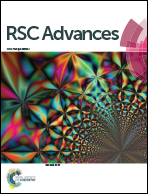Enhanced H2 dissociative phenomena of Pt–Ir electrocatalysts for PEMFCs: an integrated experimental and theoretical study
Abstract
Favorable dissociative adsorption of H2 on electrocatalysts is a key requirement of the anode in a proton exchange membrane fuel cell (PEMFC). To enhance the electrocatalytic activity of the anode, we investigated the characteristics of the hydrogen oxidation reaction (HOR) on bimetallic nanoparticles of Pt–Ir over a carbon support. The nanoparticle Pt–Ir/C catalysts improved the HOR, owing to strong H2 dissociation and ready formation of H+ atoms. In addition, we investigated the adsorption configuration and electronic band-gaps of the optimized structure using density functional theory calculations, to gain insight into the mechanisms and characteristics of H2 dissociation on Pt (111), Ir (111), and Pt–Ir (111). The reaction profile of H2 dissociative adsorption on the catalysts indicated enhanced HOR on Pt–Ir (111) compared to pure Pt (111), which was attributed to more favorable H2 dissociation in the former, owing to a reduced electronic band-gap. The integrated experimental and theoretical study suggests that Pt–Ir/C is a potential candidate for preserving the high performance of an anodic electrocatalyst in PEMFCs.


 Please wait while we load your content...
Please wait while we load your content...